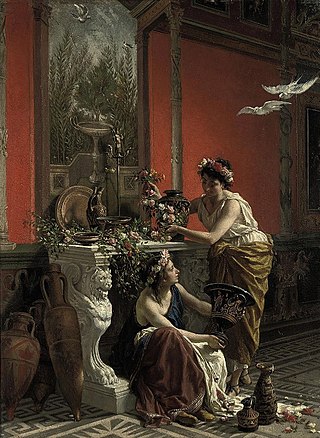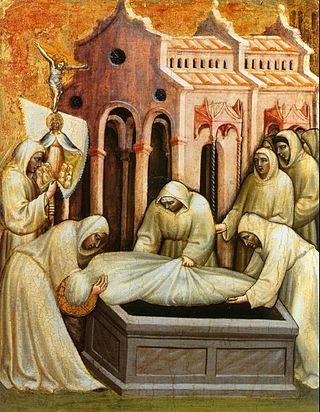
Fabriano is a town and comune of Ancona province in the Italian region of the Marche, at 325 metres (1,066 ft) above sea level. It lies in the Esino valley 44 kilometres (27 mi) upstream and southwest of Jesi; and 15 kilometres (9 mi) east-northeast of Fossato di Vico and 36 kilometres (22 mi) east of Gubbio. Its location on the main highway and rail line from Umbria to the Adriatic make it a mid-sized regional center in the Apennines. Fabriano is the headquarters of the giant appliance maker Indesit.

Pinturicchio, or Pintoricchio, also known as Benetto di Biagio or Sordicchio, was an Italian Renaissance painter. He acquired his nickname because of his small stature and he used it to sign some of his artworks that were created during the fifteenth and sixteenth centuries.

Cesare Mariani was an Italian painter and architect of the late-19th century, active in Rome and Ascoli Piceno.

The Abbey of Sassovivo is a Benedictine monastery in Umbria in central Italy. Administratively, it is a frazione of the comune of Foligno.

Bicci di Lorenzo (1373–1452) was an Italian painter and sculptor, active in Florence.
di Pietro or Di Pietro is an Italian surname. Notable people with the surname include:

The Isaac Master was an Italian Gothic painter active in the decoration of the Basilica of San Francesco d'Assisi in Assisi at the end of the thirteenth century. Master's name is derived from a fresco painting of the death of Isaac for which he is known, the fresco is located in the Upper Church of St Francis at Assisi, depicting Isaac blessing Jacob and Esau.

Olivuccio Ceccarello di Ciccarello was an Italian painter. Little is known of his life. He was a native of Camerino and was active from 1388 until his death. In 2002 works formerly attributed to an obscure painter named Carlo da Camerino were re-attributed to Olivuccio di Ciccarello as it had become clear Carlo da Camerino had never existed.

Giovanni Battista Cavagna, also known as Cavagni or Gavagni was an Italian architect, engineer, and painter mainly in Naples, but also in Rome and Ascoli Piceno, Italy.
Lattanzio Pagani was an Italian painter of the late-Renaissance or Mannerist period, active mainly in Umbria.
Liborio Coccetti was an Italian painter.

Giovanni di Corraduccio, also called Giovanni Mazaforte, was an Italian painter of the Gothic style, active mainly in Umbria and Marche.
Meo di Pero, also called Meo di Piero was an Italian painter active in Siena in a Gothic style. He worked in the studio of Cristoforo di Bindoccio. All the latter paintings are generally co-attributed to Meo, since no independent work is known.
San Marco Evangelista is a Roman Catholic church in the town of Osimo, region of Marche, Italy.
Arcangelo di Cola was an Italian painter, active throughout central Italy in a late Gothic style.
Santa Chiara is a Roman Catholic church and monastery in the town of Camerino, province of Macerata, region of the Marche, Italy. It is located just outside the old city walls, and is best known for housing for during the late 15th and early 16th centuries, the Clarissan nun, Saint Camilla Battista da Varano.

San Francesco is a Roman Catholic church and convent located inside the municipality of Valfornace, province of Macerata, region of Marche, Italy.
The Master of Staffolo was an anonymous late-Gothic style painter active in the region of Marche and Umbria.
Andrea Vici (1743–1817) was an Italian architect and engineer, active in a Neoclassical style. He was a pupil of Luigi Vanvitelli, and active in the Papal States comprising parts of Lazio, Umbria, and Marche.

Santa Maria Assunta is a Gothic and Romanesque style, Roman Catholic church in the town of Vallo di Nera, province of Perugia, region of Umbria, Italy.











